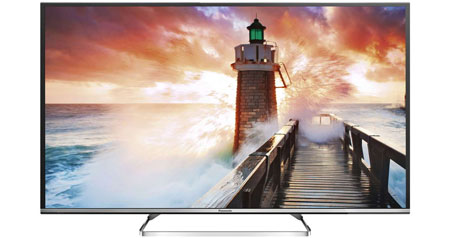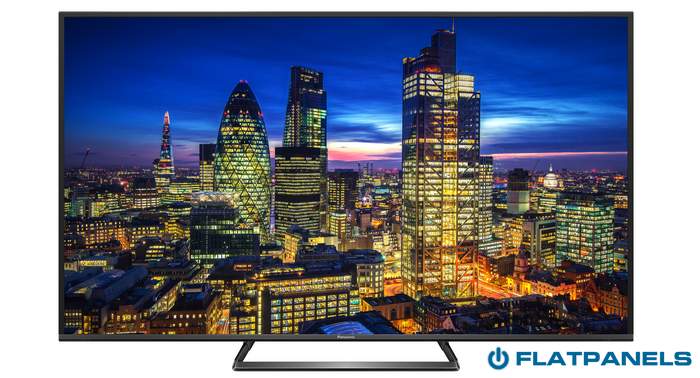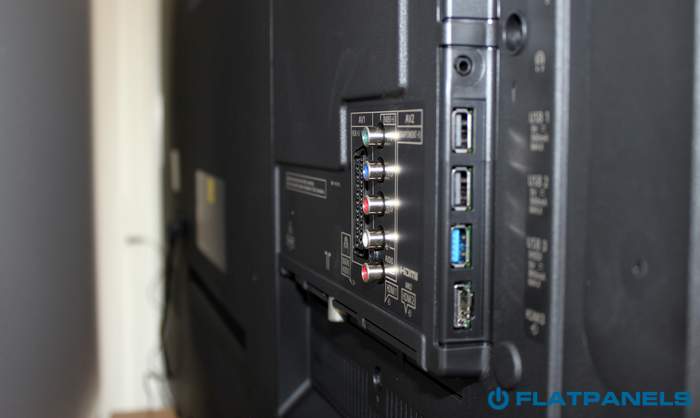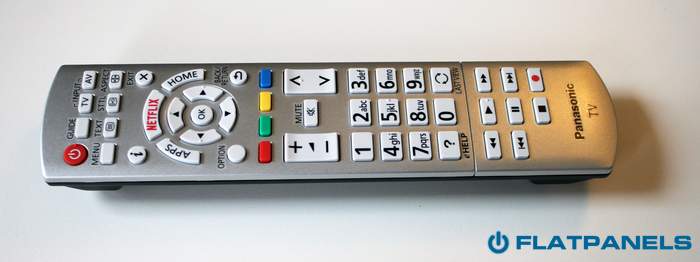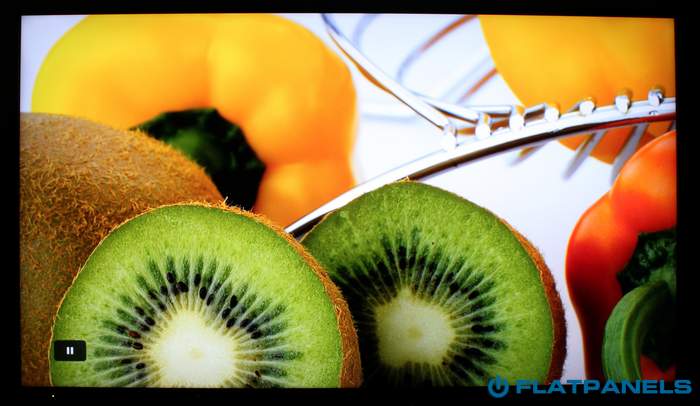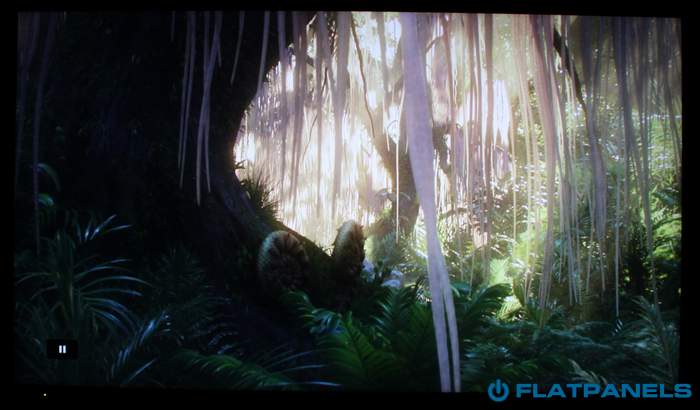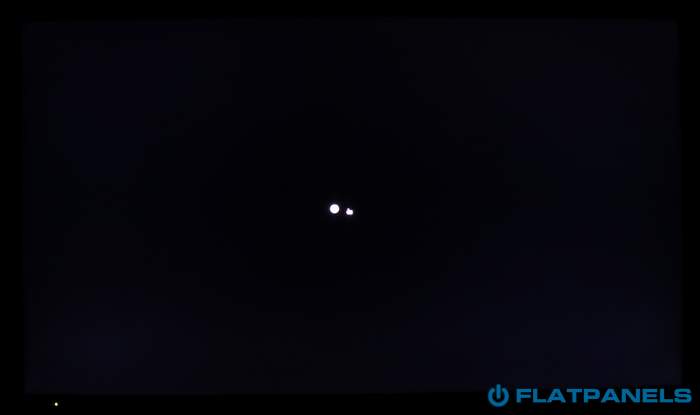Review: Panasonic CX6 (CX650 / CX680)
Our first impressions - Test tools - Functionality - Power consumption - Calibration - Picture quality - PC & Media Center - Viewing angles - Sound - Conclusion - Debate
Ultra HD is spreading fast and is becoming the norm even on mid-range TVs. CX6 is exactly that; a mid-range Ultra HD TVs. It has the most basic Ultra HD features, meaning 4K resolution, a HDMI 2.0 port and HEVC/VP9 decoding for decoding 4K content. It is also a step down from the slightly more expensive CX7 that we recently reviewed, but it still offers the new Firefox OS experience.
So what can you expect from an affordable mid-range Ultra HD TV? Could CX6 be the successor to last year’s AS640 - just with Ultra HD? We will find out.
The TV is called CX680 in Europe and CX650 in the US. There are some minor differences but none of critical importance.Price and retailers:
Specifications
55" Ultra HD (3840x2160) VA LCD with backlit LED Ingen 3D Stand (fixed)
Wall (VESA 400)(HxBxD) 71.9 x 124.2 x 5.6 cm (without stand) 19.5 kg HDMI (3x 2.0)
USB (1x 3.0 - 2x 2.0)Optical
HDMI-ARC (2x)
HeadphonesStereo DVB T/T2/C
WiFi (n-standard)MPEG4
HEVC
VP9Firefox OS Remote control (infrared)
Smartphone app (Viera TV Remote2)Manual
Remote controlPrice and retailer:
First impressions
Panasonic CX6 is a pretty TV like most other mid-range TVs today. The cabinet is only a few centimeters thick and the bezel around the LCD panel is black with a silver border at the top.Unlike many mid-range TVs, the base is actually made from metal, which is a nice detail. The CX7 that we had standing next to it has a simple two-legged stand, whereas CX6 has a centered rectangular base that still provides a solid foundation for the TV.
The back side is made from dark grey plastic, like most TVs today, so we suggest you place it close to a wall or mount it directly on the wall. The back side is not meant to be seen. It uses the standard VESA holes for wall-mounting.
Most input connectors face either down or to the side, making it easy to wall-mount the TV. Only a few of the legacy analog inputs face out towards the back wall. That is not a big concern for us because you should not use them anyways. They were obsolete for HD and totally irrelevant for Ultra HD.
All in all a pretty - but not unique - TV. It looks like most other TVs today.
Energy consumption
 |  | |
| Standby | 0.0 W | 0.0 W |
| SD+HD | 96.7 W | 86.5 W |
After calibration we measured an average power consumption of 86 W, which is fine for a 55-inch Ultra HD TV. It is slightly higher than the most efficient 55-inch Full HD TVs, but Ultra HD requires a bit more juice so that was expected.
Test tools
Our TV signal is DVB-S (satellite) from Canal Digital and DVB-T (terrestrial). Testing is done with the DVE (digital video essentials) and Peter Finzel test DVD. Testing is also done via Blu-Ray and Media center/PC. We also use a Leo Bodnar input lag tester.We use our own monitorTest. The software supports some of the traditional test patterns used to evaluate displays as well as some new and unique test patterns developed by the people here at FlatpanelsHD.
All contrast measurements are based on the ANSI methodology.
webOS and media features
Panasonic CX6 comes with only one remote control, unlike the CX7 models that also come with a new smart remote for Firefox OS. To be clear, CX6 still has Firefox OS and it also has the new Netflix button on the elongated, grey plastic remote, so you can still control everything that Firefox OS has to offer.We talked a lot about Firefox OS in our Panasonic CX7 review and it looks identical on CX6 so instead of repeating everything we refer you to the CX7 review.
Calibration of Panasonic CX6
Below you see our first measurements in the "Standard" mode. Nothing has been changed, except the light sensor that has been deactivated.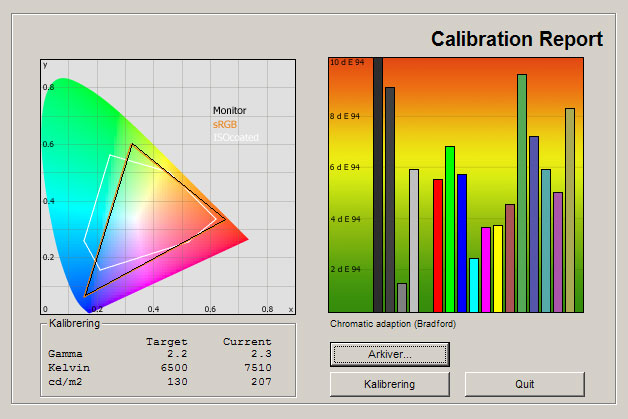
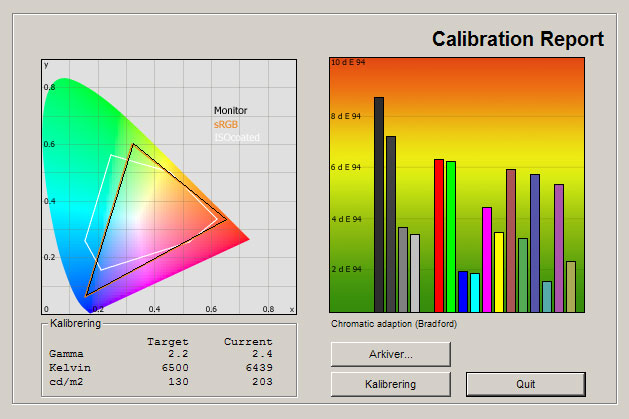
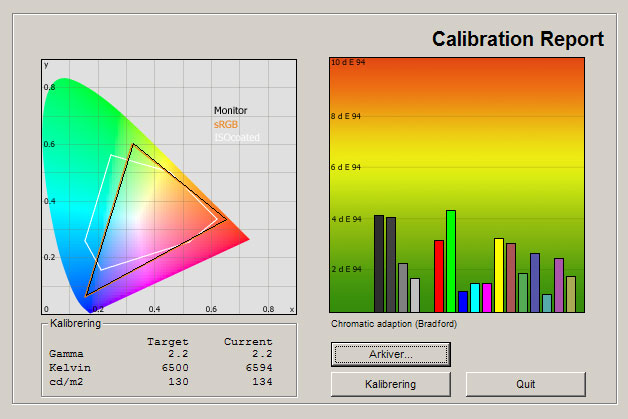
Same old, same old. The defaults settings are far from impressive and you if you want the best possible picture quality you will need to change a few things. As you can see, most colors are quite oversaturated and inaccurate. Let us quickly move on.
We switched to the Cinema profile and took a new reading. The Cinema profile is far better, but still not as accurate as the THX profile that Panasonic offers on more expensive TV. It has a slightly too high gamma, which also affects the dark grey tones that are crushed to some degree. Brightness was measured to 203 cd/m2, which is a bit too high for a dimly lit room but fine for most living rooms. Be aware that we have deactivated the automatic light sensor. Most colors are below delta 6 but we aim for better accuracy.
We tweaked the settings a bit, fairly minor changes that probably should have been corrected by Panasonic before shipping. We managed to get a more accurate gamma curve and better color accuracy for better overall picture quality. As you can see, the end result is quite impressive, especially considering that CX6 is an affordable mid-range TV.
If you are an advanced user and want to go deeper with your own equipment we should probably note that there are advanced settings for color and gamma available. These settings have to be adjusted for each specific TVs so we left them alone for our calibration suggestion below.
| Measurements | Out-of-box | Calibrated |
|---|---|---|
| Black level | 0.05 cd/m2 | 0.03 cd/m2 |
| Brightness | 207 cd/m2 | 134 cd/m2 |
| Contrast | 4140:1 | 4467:1 |
| Input lag | 80 ms 55 ms (Game) | 55 ms |
| Power consumption | Out-of-box | Calibrated |
|---|---|---|
| On | 97 W | 86 W |
| Stand-by | 0.0 W | - |
| Calibration | Setting | Value |
|---|---|---|
| General | Picture mode | Cinema |
| Backlight | 24 | |
| Contrast | 80 | |
| Brightness | 0 | |
| Color | 50 | |
| Sharpness | 0 | |
| Light sensor | On/Off | |
| Advanced | Color temp | Warm1 |
| Vivid color | Off | |
| Adaptive backlight | Off | |
| Noise reduction | Off | |
| MPEG noise reduction | Off | |
| Contrast control | Off | |
| Gamma | 2.1 | |
| 16:9 Overscan | Off | |
| R gain | +4 | |
| G gain | -4 | |
| B gain | 0 | |
| R cutoff | +2 | |
| G cutoff | -2 | |
| R cutoff | 0 |
Note: Use a higher value for backlight if you plan on using the TV during sun hours or enable the ambient sensor if you want the TV to automatically adjust the backlight levels depending on its surroundings.
Picture quality
Panasonic CX6 does not use a front glass but still has a semi-glossy coating on the panel. It does reflect some light from windows and lamps behind you but it is tolerable. If you turn up the backlight setting option the TV will do well in even a brightly lit living room. Colors remain vivid and most reflections are avoided (except in dark scenes).Processing of TV channels is fairly good. Panasonic has historically had good, accurate picture processing and CX6 benefits from that. Scaling is better than on some other mid-range TVs, including LG UF8500, and SD content generally looks good. HD pictures look detailed and we noticed that CX6 has good deep blacks, too. The picture looks rich and vivid. The TV also detects 1080p24 Blu-ray movies correctly.
For now, all TV broadcasts are in SD, 720p HD or 1080i, almost never 1080p. If you want Panasonic CX6 to shine you need to input 4K content and at the moment Netflix and YouTube are the only options. Netflix offers some original TV series in 4K as well as a few movies and documentaries. There is not much to enjoy yet but it can look great. YouTube’s 4K is also supported but you obviously need to find a clip that has been uploaded in 4K. However, none of the two apps work yet so we cannot comment on it.
4K streaming is possible because the TV supports HEVC and VP9, next-generation compression formats after MPEG4 (H.264). Last year, HEVC decoding was missing in many mid-range Ultra HD TVs but this year virtually all of the Ultra HD TVs from the top brands have it, including CX6. In addition, it has VP9 that was missing in every TV last year, says Panasonic. That is important going forward as more and more streaming services will start streaming in 4K using HEVC or VP9 compression.
You can benefit from 4K resolution on a 55-inch TV but you need to move a bit closer. We did extensive testing two years ago in our Sony X9 review. However, an even bigger TV is obviously preferable to get more out of the extra pixels. Based on our testing, if we were to buy a 55-inch TV we would gladly pay a bit extra to get Ultra HD. If we were to buy a 65-inch it would be a no-brainer.
We also had a chance to compare Panasonic CX6 side-by-side to CX7 and we noticed some differences between the two TVs. At first sight, CX6 could look like a CX7 without 3D but the latter also has slightly more advanced color processing, which showed during our tests. CX6 had some lines in our gradients tests (mostly in red and green tones) and is not reproducing all color nuances correctly. It has some issues in the darker end as all LCD panels do, but we also noticed some minor issues in the mid-segment of color tones.
CX7 also uses a faster panel and comparing the two we noticed that it has a bit less blurring than CX6. CX6 is not bad but we did notice some overdrive trailing (white halos around moving objects) that gamers might notice. It is not critical issues but CX7 did just a tad better.
For gaming, input lag is also a factor. You can see our measurements below and if you compare with CX7 you will notice that input lag is more or less the same. 55 ms input lag should be low enough for most users but discerning gamers will likely prefer a slightly faster TV. Also, keep in mind that the current PlayStation 4 and Xbox One game consoles max out at 1080p so there is really no benefit in buying an Ultra HD TV if you want a TV primarily for gaming.
Panasonic CX6 has no 3D function.
 |  | |
| Black level | 0.05 cd/m2 | 0.03 cd/m2 |
| Brightness | 207 cd/m2 | 134 cd/m2 |
| Contrast ratio | 4140:1 | 4467:1 |
| Input lag | 80 ms (55.2 ms in Game mode) | 55.4 ms |
Contrast ratio +/- 100
Panasonic CX6 is based on a VA-type LCD panel and as you can see, the contrast measurement are great, for a LCD panel. After calibration, we measured black depth to 0.03 cd/m2, which is impressive for a mid-range LCD TV. In a dark room you will still notice that black is not 100 % black but it is low enough to make most dark movie scenes look vivid and intense.
Shadow detailing is fair but comparing it to CX7 the bigger brother still manages to pull ahead by a hair or two. Both TVs can reproduce most grey tone steps.
Below we have examined CX6 in a completely dark room to see if it has clouding or backlight bleeding.
There is almost zero bleeding or clouding on the panel. Panasonic CX6 uses a backlit LED (only in 55") so this was somewhat expected but it is still pleases our eyes to sit in front of an unproblematic LCD panel.
PC and Media Center
In order to achieve 1:1 pixel mapping you need to select the aspect ratio called "16:9" in the TV settings and set "16:9 Overscan" to off. Unfortunately we do not yet have a PC in the testing room that can output 4K at 60Hz so we cannot confirm if the TV can reproduce full RGB 4:4:4 4K at 60Hz.Viewing angles
Panasonic CX6 has one of the better VA panels but it still has some viewing angle issues, just like its bigger brother. If viewing angles are important to you the best choice in LCDs is still IPS, like the ones LG uses. OLED TVs have virtually perfect viewing angles, but are obviously still expensive.Most colors start to look washed out from around 30-40 degrees. Contrast also drops considerably, making black look grayish. For most living rooms CX6 will be fine but if you are watching from an extreme angle consider buying some kind of swivel stand or wall bracket solution.
Sound quality
The built-in speakers are not very good. The thin cabinet makes it almost impossible to integrate proper speakers and as this is a mid-range TV, Panasonic has not put in much effort either. Most people will probably find the speakers adequate for casual use but no more than that.We recommend connecting external speakers for a better sound experience.
Conclusion
Panasonic CX650 (in the US) / CX680 (in Europe) offers, like the more expensive models, the new Firefox operating system, created by Mozilla. We gave you a tour in our CX7 review. To sum up, it is a more user-friendly system than the old one in Panasonic’s TVs, but we still have our doubts as to whether it can compete with more full-fledged TV platforms. It is also disappointing that the channel/recording capabilities have not been integrated into Firefox OS. The channel interface still looks like something from the eighties. Firefox OS is a welcomed improvement, but just not a home run.Turning to picture quality, CX6 and CX700 have more similarities than differences. CX6 is also a good all-round TV with no critical issues. The TV has good color reproduction, relatively deep blacks, and nice HD picture quality. However, if you want to benefit from the 4K resolution you need to feed it with 4K content. There is no other way. On the cons list we have the viewing angles and some minor differences compared to CX7.
So, in essence CX6 looks mostly like a design variant of the CX700, and we found a lot to like. It has the potential to be a value-for-money TV but considering the tiny price difference, we would probably take one step up to CX7. Maybe that will change later in the year.
Compare prices for Panasonic CX680 on Pricerunner
Price and retailers:
Picture quality is assessed as overall picture quality, including color reproduction, image processing, contrast, motion etc.
Features is an evaluation of the built-in functionality such as apps, connector ports, tuners, recording capabilities, decoder formats, and how useful they are, as well as sound quality.
User experience is evaluated on the basis of user friendliness, speed, build quality, and day-to-day use of the TV
Total score is weighted: 50% Picture quality, 25% Features, 25% User experience.
All scores are calculated based on a moving maximum target, defined by what we currently consider the best on market. It is then presented as a percentage. This means that a score will fall over time as new and better TVs set new standards. This allows you to compare scores across years. A score of 100% in a given category means that it is consider the best available product in this category to date.
Features is an evaluation of the built-in functionality such as apps, connector ports, tuners, recording capabilities, decoder formats, and how useful they are, as well as sound quality.
User experience is evaluated on the basis of user friendliness, speed, build quality, and day-to-day use of the TV
Total score is weighted: 50% Picture quality, 25% Features, 25% User experience.
All scores are calculated based on a moving maximum target, defined by what we currently consider the best on market. It is then presented as a percentage. This means that a score will fall over time as new and better TVs set new standards. This allows you to compare scores across years. A score of 100% in a given category means that it is consider the best available product in this category to date.
Picture quality
Good black level for LCD
Firefox OS is user friendly
No clouding/bleeding
Speakers
Picture modes not optimal
Few apps for Firefox OS

